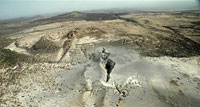Giant Crack in Africa Will Become New Ocean
Researchers hypothesize that a miles-long crack in the Ethiopian desert may eventually become an ocean.

A new study from the journal Geophysical Research Letters reports that a 20-foot wide crack in the center of the Ethiopian desert will eventually become a new ocean.
In a recently released study, scientists revealed how a rift from a volcanic eruption tore open a 35-mile crack in just days, reports MNN.
The 60-kilometre (35-mile) split in the desolate Afar region, which was the result of two volcanic eruptions in September 2005, has enabled scientists to further examine the earth's tectonic movements, said a report published in the Geophysical Research Letters.
"The significance of the finding is that a huge magnetic deformation can happen within a few days like in oceans," Atalay Arefe, an Ethiopia-based university professor who was part of the study, told AFP in an interview.
Researchers say faults and fissures, which normally occur deep down on the ocean floor, are the main processes by which continents gradually break off from each other. They cite Africa, which underwent a similar phase when it split from America millions of years ago, AFP reports.
"We know that seafloor ridges are created by a similar intrusion of magma into a rift, but we never knew that a huge length of the ridge could break open at once like this," said Cindy Ebinger, professor of earth and environmental sciences at the University of Rochester and co-author of the study.
The result shows that highly active volcanic boundaries along the edges of tectonic ocean plates may suddenly break apart in large sections, instead of in bits, as the leading theory held.
And such sudden large-scale events on land pose a much more serious hazard to populations living near the rift than would several smaller events, Ebinger said, according to LiveScience.com
Subscribe to Pravda.Ru Telegram channel, Facebook, RSS!





